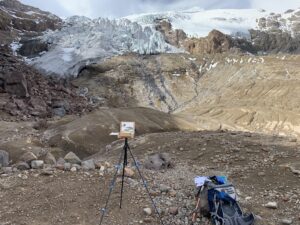Visiting the Rhône Glacier in Switzerland was just the beginning of a unique research project for psychology and art major Emily Dzieweczynski ’19 and Associate Professor of Art, Betsy Byers. Sharing the same interest in climate change, Dzieweczynski and Byers collaborated on a creative endeavor to inspire compassion and empathy for the planet. Together, they created an interactive exhibit using virtual reality technology that allows people to fully experience the essence of glaciers without visiting a glacial site.
The goal of Byers and Dzieweczynski’s work was to help people create empathy towards the environment, resulting in an altered attitude towards climate change. To reach this goal, they created a multi-sensory art space that provides the full experience of seeing, hearing, smelling, and feeling what it is like to be in the presence of a glacier.
Byers created paintings for Dzieweczynski to animate using virtual reality technology. “Art can help communicate in all different forms,” says Byers. “Many people don’t think about the intersection between art and science but there’s a lot. The student faculty collaborations are when the liberal arts come alive. We study everything through the lens of art.”
While working on this project, the opportunity to travel with assistant Geography and Environmental Studies Professor, Dr. Jeff La Frenierre arose: a trip to Ecuador to visit a glacial research site with La Frenierre and Biology and Environmental Studies major, Brianna Jol ’20. This interdisciplinary partnership provided a unique way to communicate scientific findings. During their expedition, they experienced the melting glaciers and the despair felt by the local community firsthand.
Dzieweczynski and Byers’s interactive art exhibit has inspired awe and curiosity in many students, professors, and visitors who have experienced their exhibit about virtual reality technology “I learned about new software, new technology, grant writing, networking, project management, and teamwork” says Dzieweczynski. “I also discovered a lot about the world around me and the different ways of understanding and speaking about it from artists and scientists.”
Dzieweczynski graduated in 2019 and is still working with Byers to showcase their work. “Personally, I’m using the tools and knowledge that I’ve developed on this project to strengthen my own body of work and studio practice,” said Dzieweczynski. Byers and Dzieweczynski have presented their work at several locations such as the American Swedish Institute and Minnesota Mankato State University, Mankato.
Their collaboration was funded by a 2018 Presidential Faculty-Student Research Grant.